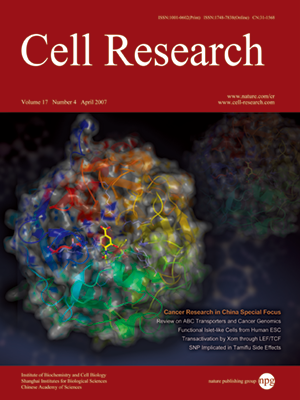
Volume 17, No 4, Apr 2007
ISSN: 1001-0602
EISSN: 1748-7838 2018
impact factor 17.848*
(Clarivate Analytics, 2019)
Volume 17 Issue 4, April 2007: 333-344
ORIGINAL ARTICLES
In vitro derivation of functional insulin-producing cells from human embryonic stem cells
Wei Jiang1,*, Yan Shi1,5,*, Dongxin Zhao1, Song Chen1, Jun Yong1, Jing Zhang2, Tingting Qing1, Xiaoning Sun1,3, Peng Zhang1, Mingxiao Ding1, Dongsheng Li4 and Hongkui Deng1,2,3
1Department of Cell Biology and Genetics, College of Life Sciences, Peking University, Beijing 100871, China
2Beijing Laboratory Animals Research Center, Beijing 100012, China
3Laboratory of Chemical Genomics, Shenzhen Graduate School of Peking University, the University Town, Shenzhen 518055, China
4Provincial Key Laboratory of Embryonic Stem Cell Research, Tai-He Hospital Yunyang Medical College, 32 S. Renmin Rd., Shiyan 442000, China
5Present address: The Scripps Research Institute, Chemistry Department, SP3130, 10550 North Torrey Pines Road, La Jolla, CA, USA.
Correspondence: Hongkui Deng Dongsheng Li(hongkui_deng@pku.edu.cn dsli@yymc.edu.cn)
The capacity for self-renewal and differentiation of human embryonic stem (ES) cells makes them a potential source for generation of pancreatic beta cells for treating type I diabetes mellitus. Here, we report a newly developed and effective method, carried out in a serum-free system, which induced human ES cells to differentiate into insulin-producing cells. Activin A was used in the initial stage to induce definitive endoderm differentiation from human ES cells, as detected by the expression of the definitive endoderm markers Sox17 and Brachyury. Further, all-trans retinoic acid (RA) was used to promote pancreatic differentiation, as indicated by the expression of the early pancreatic transcription factors pdx1 and hlxb9. After maturation in DMEM/F12 serum-free medium with bFGF and nicotinamide, the differentiated cells expressed islet specific markers such as C-peptide, insulin, glucagon and glut2. The percentage of C-peptide-positive cells exceeded 15%. The secretion of insulin and C-peptide by these cells corresponded to the variations in glucose levels. When transplanted into renal capsules of Streptozotocin (STZ)-treated nude mice, these differentiated human ES cells survived and maintained the expression of beta cell marker genes, including C-peptide, pdx1, glucokinase, nkx6.1, IAPP, pax6 and Tcf1. Thirty percent of the transplanted nude mice exhibited apparent restoration of stable euglycemia; and the corrected phenotype was sustained for more than six weeks. Our new method provides a promising in vitro differentiation model for studying the mechanisms of human pancreas development and illustrates the potential of using human ES cells for the treatment of type I diabetes mellitus.
Cell Research (2007) 17: 333-344. doi: 10.1038/cr.2007.28; published online 10 April 2007
FULL TEXT | PDF
Browse 1932


